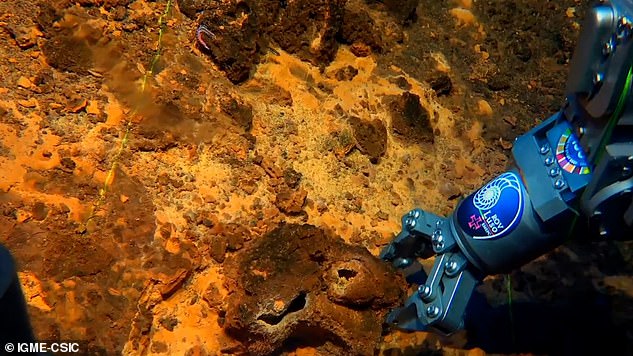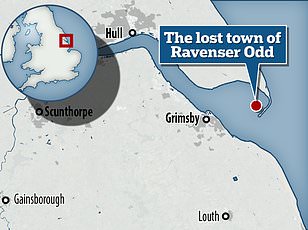- The newly-found sunken islands are named 'Los Atlantes' in a nod to Atlantis
- READ MORE: Is this the first look at a lost civilisation linked to Atlantis?
Atlantis is the world's most famous fictional island, invented by Greek philosopher Plato 2,300 years ago.
But Spanish researchers claim to have found the source of his inspiration – a series of sunken islands off the northwest coast of Africa.
The former islands would have been close to the modern-day Canary Islands, but they sunk millions of years ago, the experts think.
They've christened the now-submerged lands 'Los Atlantes', in reference to the myth of Atlantis which still persists today.
Luis Somoza, a marine geologist at Geological Survey of Spain (IGME-CSIC), told Live Science: 'This could be the origin of the Atlantis legend.'

The underwater islands, located east of Lanzarote, may have provided inspiration for the myth of Atlantis, the experts say

According to a statement, the islands were located east of Lanzarote (shaded in red) which is one of the seven main Canary Islands that are located just off the coast of Africa
Somoza and colleagues do not specify how exactly Plato – who was alive about 2,300 years ago – would have known about the islands.
The team estimate that Los Atlantes existed as islands during the Eocene time period, between 56 and 34 million years ago.
They were located east of Lanzarote, which is one of the seven main Canary Islands that are located just off the coast of Africa.
'They were islands in the past and they have sunk, they are still sinking, as the legend of Atlantis tells,' said Somoza.
'Some of us have been able to verify that they still maintain their beaches.'
As part of a exploration project that kicked off on June 27 and ended last week, the team deployed an unmanned submarine.

As part of a exploration project that kicked off on June 27 and ended last week, the team deployed an unmanned submarine

The unmanned submarine investigated the state of the seabed between 330 and 8,200 feet (100 and 2,500 metres) deep
The unmanned submarine investigated the state of the seabed between 330 and 8,200 feet (100 and 2,500 metres) deep.
It used high-resolution cameras, robotic arms for taking samples from the seabed and sensors for gases such as CO2 and methane in the water.
Today, Los Atlantes are now covered with 'vast life', from gardens of corals and sponges to areas covered with 'bacterial mats' – multi-layered sheets of microorganisms, researchers say.
The islands are located on a massive 'seamount' – an underwater mountain with steep sides rising from the seafloor that contains three inactive volcanoes.
The seamount is about 31 miles (50 km) in diameter, while its base is about 1.4 miles (2.3 km) below the surface of the ocean.
The islands may have sunk when the volcanoes stopped erupting and lava solidified and became denser.

It's generally believed the story about the world of Atlantis was first told 2,300 years ago by the Greek philosopher Plato (depicted)

It's generally believed the story about the world of Atlantis was first told 2,300 years ago by the Greek philosopher Plato who made it up, but some history fans persist with the idea that it actually existed (artist's impression)
Land sinking to the seafloor is not unusual; in fact Britain is also surrounded by former islands and coastal spots that are now submerged, many sunk by wild weather events.
One of these is Ravenser Odd, a short-lived medieval city on an island in the Humber Estuary, described as 'Yorkshire's Atlantis'.
While there's little doubt that many of these existed based on contemporary records, the same can't be said about Atlantis.
It's generally believed the story about the world of Atlantis was first told 2,300 years ago by the Greek philosopher Plato who made it up, but some history fans persist with the idea that it actually existed.
One theory about where the lost civilization disappeared to is that it was swallowed up by the Bermuda Triangle.
The patch of the Atlantic Ocean, also known as the Devil's Triangle, became an urban legend after more than 50 ships and 20 airplanes disappeared in the area.
Another theory was that it was destroyed by a natural disaster such as mass flooding, an earthquake or volcanic eruption.
Another research team recently revealed they'd found Germany's equivalent of Atlantis – the town of Rungholt, which was sunk by a storm in 1362.
















































































































































































































































